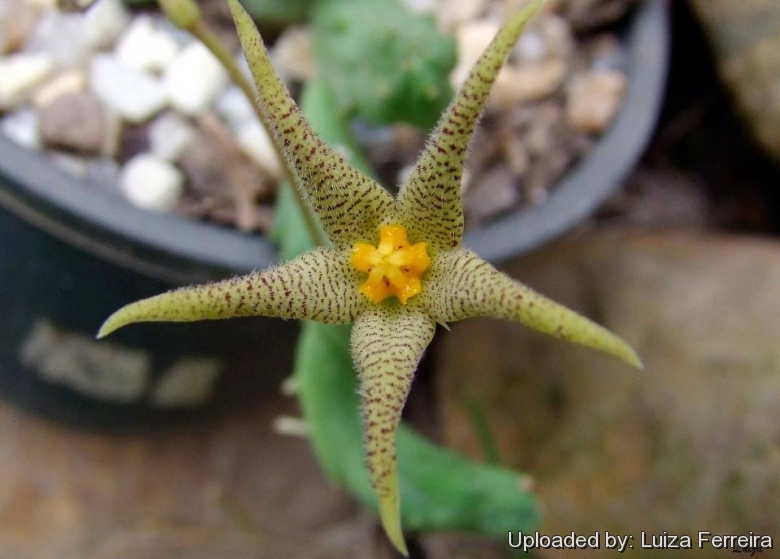Accepted Scientific Name: Piaranthus cornutus N.E.Br.
Fl. Cap. (Harvey) 4: I. 1018 (1909) Harv.

Piaranthus pulcher Photo by: Luiza Ferreira
Origin and Habitat: North-western Republic of South Africa (Little Namaqualand).
Synonyms:
See all synonyms of Piaranthus cornutus
Description: Piaranthus pulcherSN|30433]]SN|30441]] is a morphological or geographical form of the variable Piaranthus cornutusSN|30441]]SN|30433]]. It characterizes in the bright clear greenish-yellow flowers, marked all over with small rounded dark purple-brown spots. However the differences with standard P. cornutus are subtle if any. Piaranthus pulcherSN|30433]]SN|30441]] mentioned in old literature and sometimes offered in plant lists, should be fully synonymized with Piaranthus cornutusSN|30441]]SN|30433]].
Stems: Tufted, 1-2.5 (or more) cm long, 8-12 mm thick, subglobose or oblong, obtusely 4-angled, with small tubercle-like teeth, glabrous, greyish-green or somewhat glaucous.
Flowers: 1–4 (often 2) together, near the middle or tips of the stems; pedicels erect, 6-12 mm long, stout, thickened upwards, glabrous. Sepals c. 4 mm long, linear-lanceolate, acuminate, glabrous. Corolla subrotate, without a distinct tube, c 2 cm in diameter, glabrous and dull greenish-brown on the back, inner face velvety-pubescent with white and purple hairs, bright clear greenish-yellow, marked all over with small rounded dark purple-brown spots. Corolla-lobes not spreading horizontally, 9-10 mm long, 4 mm broad at the base, thence tapering in a nearly straight line to the apex, with revolute margins. Corona-lobes 2 mm or rather more in length, linear-subulate, incumbent on the backs of and much exceeding the anthers, with short subdenticulate acute connivent-erect tips, dorsally produced at the base into a quadrate crest, flat and papillate on the top, clear deep yellow, without markings.
Subspecies, varieties, forms and cultivars of plants belonging to the Piaranthus cornutus group
- Piaranthus cornutus N.E.Br.: flowers brownish-yellow, pale yellowish, or whitish on the inner face heavily mottled with dark red and with with dense white hairs. Distribution: South Namibia, and north-western South Africa.
 Piaranthus cornutus var. ruschii (Nel) Bruyns: Flowers greenish yellow with dense white hairs white hairs (usually unspotted). Distribution: Southern Namib, Namibia.
Piaranthus cornutus var. ruschii (Nel) Bruyns: Flowers greenish yellow with dense white hairs white hairs (usually unspotted). Distribution: Southern Namib, Namibia.  Piaranthus pulcher N.E.Br.: Has bright clear greenish-yellow flowers, marked all over with small rounded dark purple-brown spots. Distribution: South Africa, Little Namaqualand.
Piaranthus pulcher N.E.Br.: Has bright clear greenish-yellow flowers, marked all over with small rounded dark purple-brown spots. Distribution: South Africa, Little Namaqualand.
Bibliography: Major references and further lectures
1) N. E. Brown. “Flora Capensis”, Vol 4, page 518, 1909
2) Focke Albers, Ulrich Meve “Illustrated Handbook of Succulent Plants: Asclepiadaceae: Asclepiadaceae” Volume 4 Springer Science & Business Media, 2002
Cultivation and Propagation: Piaranthus pulcherSN|30441]]SN|30441]] is an easy blooming plant when mature that require moderately watering through the growing season but enjoy plenty of water and some fertiliser in hot weather, this helps them to flower freely. Water more sparingly in winter according to temperatures. But, as with most asclepiads, it is unwise to leave them wet in cold weather. Winter care presents no problems at 5°C with plenty of light. Since roots are quite shallow, use a cactus mix or add extra perlite or pumice to regular soil potting soil. A gritty, very free-draining compost is suitable, and clay pots help the plants to dry out between watering.
Sun Exposure: Partial sun or light shade
Pest and diseases: Piaranthus species vary in their susceptibility to rotting, but are generally fairly easy to grow, especially if kept pest-free. They are very susceptible to stem and root mealy bugs, and damage from these may well initiate fungal attack. If you do have problems with a stem or with basal rotting, you can reliably isolate the healthy parts, dry them off, and re-root them in moist compost.
Cultural Practices: Re-pot every 2 years
Propagation: Easiest with stem cuttings. Allow cuttings to dry a day before planting. Stems must be laid (Not buried) on gritty compost and will then root from the underside of the stems. It can also be increased from seeds sowing in spring in moist, sandy peat moss.
Potting medium: Since roots are quite shallow, use a cactus mix or add extra perlite or pumice to regular soil potting soil. A gritty, very free-draining compost is suitable, and clay pots help the plants to dry out between watering.










